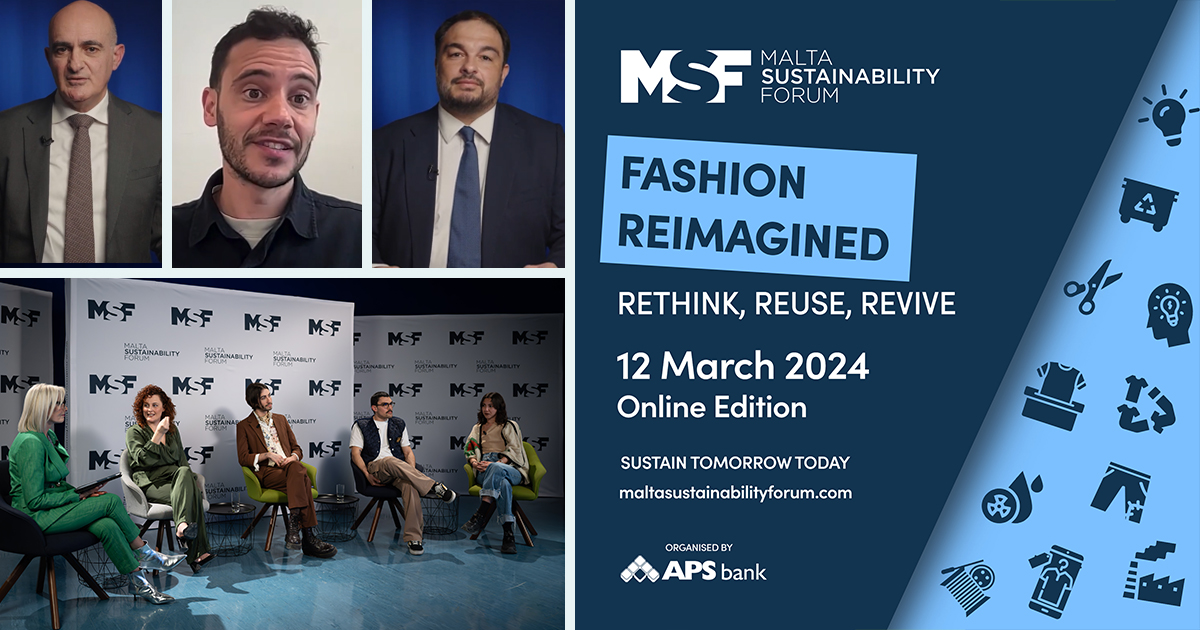People own five times more items of clothing on average as their grandparents did, according to Yolande Svensson of Hudson Group Malta, raising questions about what is driving this consumption.
This was one of the many thought-provoking facts presented during the first event organised in 2024 by the Malta Sustainability Forum, entitled “Fashion Reimagined: Rethink, Reuse, Revive”. The Forum, an APS Bank initiative, has tackled various issues over the years, from pensions to affordable housing and transport, since – as the APS Bank CEO Marcel Cassar said in his introduction – sustainability has to be seen in a wider context than just climate change.
This is not to say that fashion does not have an impact on climate change: he pointed out that it is responsible for 10% of all carbon emissions. The fashion industry is worth $2.5 trillion, employing over 75 million people worldwide, and therefore has a major impact on sustainable consumption as well as sustainable production – from farming and its environmental impact to issues involving labour.
The online event analysed not only the threats posed by the fashion industry – which notoriously has the power and often the budget to shape consumer behaviour – but also came up with a number of solutions on what individuals could do to mitigate the situation, what the industry itself is already doing, and how education and awareness could shape the future.
Clothing production doubled between 2000 and 2014, Mr Cassar noted, adding that by 2014 consumers only kept their clothes for half as long as they did in 2000.
The scene for the discussion was set by a manager at the Ellen MacArthur Foundation, Steve Diacono, who explained that the century-old concept of planned obsolescence dated back to a time when resources were considered to be limitless – which is no longer the case. He argued for a circular economy based on eliminating waste and pollution, circulating production and materials, and regenerating natural systems.
Mr Diacono stressed that before buying, consumers should ask not only whether they needed an item in the first place, but also whether there were other options like renting or buying items that had been previously owned, as well as saying that many items could last longer by repairing or refashioning them.
The issue then discussed by the panel was what was promoting this approach – certainly not ‘need’ as a truckload of fashion items were being landfilled every second, with 100 billion items produced every year.

Panellist Luke Azzopardi, who is the creative director of his eponymous studio, pointed out that it is worth paying more for bespoke garments, perhaps made with natural fabrics, that last longer Mr Azzopardi said that quality garments should be viewed as heirlooms – even being handed down from generation to generation. He stressed that moving away from fads, trends and seasonality could lead to garments without “an expiry date”. Also on the panel was Christian Bartolo Burlo’, whose Thrift.mt is gaining success fighting the stigma of second-hand clothing through a curated offering. He pointed out that when families were larger, they were quite used to handing things down to other family members.
Also contributing to the discussion was Tamara Fenech of Cosie Studio, who said consumers should take into account the people and systems that created the items we buy, as well as petroleum products which were used in their manufacture.
“We are churning out low quality products which don’t last,” she lamented. “Let’s slow down that cycle and normalise a new way of doing things.”
While Mr Azzopardi advocated for more natural fibres, she suggested buying fewer items that perhaps cost more but which would last longer.
“We think we need more than we actually do!”
Of course, there is a stick as well as a carrot: by 2026, companies will have to provide audits to prove their credentials for the environment, social and governance metrics – such as reporting on their carbon footprint. Ms Svensson, who spoke about the forthcoming EU law, noted the various initiatives taken by Hudson’s brands to improve their sustainability, giving as just one example sports shoes whose manufacture included recycled plastic bottles.
There are also more and more entities challenging the performance of global brands, with Ms Fenech noting that there is a Fair Trade movement for fashion, just as there is for food items, for example. One site that may prove useful for those wishing to learn more about their buying decisions is Fashion Revolution.
In his closing speech, APS Head of Sustainability Matthew Swain added to this argument for more informed behaviour, asking: “Who are we sustaining through our purchasing decisions?”. He also took up the point of external pressure, noting that the fashion industry was becoming ever more sensitive to the need to respond to growing risks, whether geopolitical instability or inflation.
“The era of self-regulation is fast drawing to a close. Across jurisdictions, new rules will have significant effects on both consumers and fashion players; indeed regulations have more than doubled over the past seven years. Just last year in June, the European Commission adopted proposals for the Waste Framework directive targeting a transition pathway for the textile ecosystem,” he said.
The keynote speech on the webinar was given by Malta’s President George Vella who gave a dire warning saying that while Governments and other stakeholders had a role to play, so do individuals: “If we do not push ourselves out of our comfort zone, sustainability will not only remain a utopian dream, but will leave us exposed to nothing less than an existential threat.”
The webinar is available on the MSF website maltasustainabilityforum.com/videos

